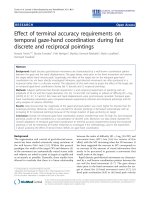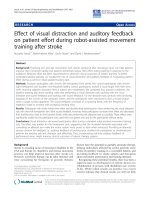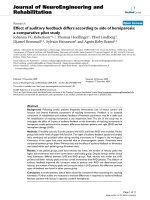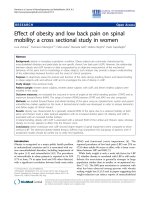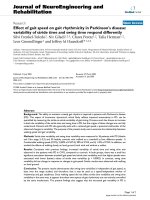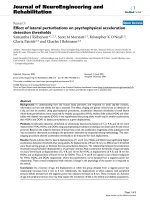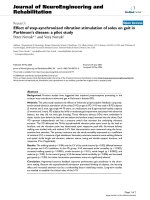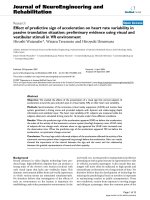báo cáo hóa học:" Effect of different cuff widths on the motor nerve conduction of the median nerve: an experimental study" doc
Bạn đang xem bản rút gọn của tài liệu. Xem và tải ngay bản đầy đủ của tài liệu tại đây (199.35 KB, 6 trang )
BioMed Central
Page 1 of 6
(page number not for citation purposes)
Journal of Orthopaedic Surgery and
Research
Open Access
Research article
Effect of different cuff widths on the motor nerve conduction of the
median nerve: an experimental study
Parul Mittal*, Shweta Shenoy and Jaspal S Sandhu
Address: Department of Sports Medicine and Physiotherapy, Guru Nanak Dev University, Amritsar, India
Email: Parul Mittal* - ; Shweta Shenoy - ; Jaspal S Sandhu -
* Corresponding author
Abstract
Background: A bloodless operative field is considered mandatory for most surgical procedures
on the upper and lower extremity. This is accomplished by using either an Esmarch bandage or a
pneumatic tourniquet, but a number of complications are associated with both. Nerve palsy is one
of the most frequently encountered complications of this procedure. Wider cuffs have been found
to cause reduced risk of tourniquet induced injury to the underlying soft tissues than the narrower
ones due to the fact that lower occlusion pressures are caused by the former. To address and
investigate this question, conduction in the median nerve has been measured proximal to
tourniquet as well as distal to the tourniquet. Parameters of nerve conduction measured are nerve
conduction velocity, latency and amplitude.
Methods: Sphygmomanometer cuffs with widths 14 cm and 7 cm were applied to the upper
extremities of 20 healthy, normotensive volunteers (9 males and 11 females with age ranging from
22 to 27). Systolic blood pressure was measured first and then the cuff was inflated to about 20–
30 mm Hg above it and was kept inflated for 15 minutes. Recordings were done prior to, for the
period of tourniquet inflation, and following release of the tourniquet.
Results: Nerve conduction was found to be more severely affected by the 14 cm cuff than the 7
cm cuff.
Conclusion: Wider cuffs resulted in more severe changes in the nerve. This brings us to the
conclusion that though lower inflation pressures are required for the occlusion of the blood supply
using wider cuffs, the nerve conduction is more severely affected by the wider ones. Both
electrophysiological changes and occlusion pressure should be kept in mind while choosing the
width of the cuff.
Background
Many studies related to tourniquet have been conducted
till date. Some of these experiments have investigated the
various complications associated with tourniquet [1-5].
No doubt tourniquets are advantageous in providing a
clear operative field view but it is also true that they
provide this advantage at the risk of many complications.
Rorabeck [6] stated that, out of many complications, the
most frequent one that should be wholly prevented are
the nerve palsies arising from the use of tourniquets.
Published: 9 January 2008
Journal of Orthopaedic Surgery and Research 2008, 3:1 doi:10.1186/1749-799X-3-1
Received: 15 January 2007
Accepted: 9 January 2008
This article is available from: />© 2008 Mittal et al; licensee BioMed Central Ltd.
This is an Open Access article distributed under the terms of the Creative Commons Attribution License ( />),
which permits unrestricted use, distribution, and reproduction in any medium, provided the original work is properly cited.
Journal of Orthopaedic Surgery and Research 2008, 3:1 />Page 2 of 6
(page number not for citation purposes)
After a surgery, it is easy to identify nerve palsy but it is
difficult to attribute it to a single defined cause. In tourni-
quet induced nerve palsies, a few studies have attributed it
to ischemia [7] and others have attributed it to deforma-
tion following pressure [8]. The width of the tourniquet is
also an important factor in deciding the extent of these
injuries. Wider tourniquet cuffs can achieve an effective
arrest of the regional arterial circulation at sub systolic
pressures of inflation [9], so it could be assumed that
these must cause less intense injury to the underlying soft
tissue structures in comparison with the narrow ones. This
is just an assumption and has not been proved till now.
This study is an attempt to shed some light on the electro-
physiological changes in the motor nerve of the median
nerve when the tourniquet of different widths is used.
Methods
The experimental protocol was reviewed and approved by
the university research ethical committee. It was an exper-
imental study with the same subject design {when one
group of subjects is tested or measured on all the condi-
tions and their performance compared it is known as
Same Subject design, Related Subject design or Within
Subject design} [10]. Subjects were thoroughly informed
about the experiment and written informed consent was
taken from them. Two sphygmomanometer cuffs of 7 cm
and 14 cm width were used as tourniquet in the study. 20
normal subjects volunteered in the investigation, the pur-
pose and procedure of which was explained to them in
advance. There were 9 males and 11 females of age rang-
ing from 22 to 27 [Mean age ± Standard Deviation [S.D.]
= 24.45 ± 1.10].
After taking the blood pressure in a standard manner, the
subject was placed in a supine position with the arm
abducted to 90° and supported comfortably. Stimulating
and recording electrodes were placed on the right upper
extremity of each subject to stimulate the median nerve.
Before placement, the skin below the electrodes
was slightly abraded to reduce impedance. A ground elec-
trode was fastened to a convenient site between the stim-
ulating and recording electrode. The recording site was
abductor policis brevis muscle. R1 and R2 electrodes were
placed in such a way that R1 is placed over the muscle
belly of abductor brevis muscle and R2 over the first
metacarpophalngeal joint. Stimulation sites were axilla
[proximal to tourniquet] and ante-cubital fossa [distal to
tourniquet].
The resting motor nerve conduction velocity [MNCV],
amplitude and latency measurements of the median nerve
for each subject were carried out before the experiments.
The decision to carry out the experiment at a particular
time with either of the cuff was random and a gap of at
least 24 hours was kept between the two experiments. The
two cuffs were inflated to 20–30 mmHg above their
respective systolic blood pressure ranging from 110 to 126
mmHg for 14 cm cuff and 140 to 166 mmHg for 7 cm cuff
and were kept inflated for 15 minutes. An inflation pres-
sure of 20–30 mmHg above the systolic blood pressure
was used as the subjects included in the study were not
anesthetized and the subjects would not have tolerated
higher pressures than this. During this time period three
recordings of the motor nerve conduction was taken by
stimulating at both the axilla and the ante-cubital fossa.
The first recording was done at 5
th
minute of inflation, the
second one at 10
th
minute and the third at 15
th
minute.
The cuff was then deflated and again recording of same
parameters were taken at 1
st
minute, 2
nd
minute, 3
rd
minute, 4
th
minute, 15
th
minute and 30
th
minute of post
deflation, stimulating the same points.
The motor nerve conduction velocity before and follow-
ing the application of the two cuffs was calculated by
dividing the distance between the two stimulation sites by
the difference in the onset latency proximal and distal to
the cuff i.e.
CV (m/s) = distance (mm)/LAT
proxtocuff
- LAT
distaltocuff
.
The percentage of MNCV, amplitude and latency was cal-
culated using the formula i.e. [value of each parameter at
different time durations/baseline value]*100
Throughout the experiment, the room temperature was
maintained between 23°C and 26°C with the help of air
conditioning. Paired t-test was used to compare the
changes in the nerve conduction parameters with the
application of 2 cuffs. All values which appear with the
mean values are standard deviations [S.D.].
Results
The present study has demonstrated that the wider 14 cm
cuff impairs conduction in the nerve more severely than
the 7 cm cuff. Initially 2-way ANOVA with post hoc
Tukey's Multiple Comparison test was applied to the
obtained data. No statistically significant difference was
obtained between the parameters compared for the two
cuffs, so a more sensitive Paired t-test was applied and the
results of the same are presented below.
Conduction Velocity
The decrease in MNCV was maximum with the 14 cm cuff.
Though decrease in the conduction velocity occurred with
both the 14 cm & the 7 cm cuff, the reduction was more
with the former. After 5 minutes of inflation of the 14 cm
cuff, MNCV was 93.01% ± 11.34 of its baseline value
Journal of Orthopaedic Surgery and Research 2008, 3:1 />Page 3 of 6
(page number not for citation purposes)
whereas with the 7 cm it was 95.40% ± 11.94. Though a
decrease was evident, statistically this was not significant
when the two tourniquets were compared. [Fig. 1]
The difference became statistically significant only after 10
minutes of inflation of the cuffs. At 10 minutes of infla-
tion, when the percentage decrease in MNCV was com-
pared for the two cuffs, a statistically significant difference
was found with the p-value ≤ 0.03. With the 14 cm cuff the
MNCV was 84.37% ± 10.15 of its baseline value after 10
minutes of inflation whereas with the 7 cm cuff the MNCV
was 93.97% ± 16.10 of its baseline value. After 15 minutes
of inflation also a significant difference was found in
between the two cuffs with the significance level of p ≤
0.04. At this time the MNCV was 73.73% ± 12.06 of its
baseline value for 14 cm cuff whereas it was 82.96% ±
16.33 for the 7 cm cuff.
The release of the tourniquet allowed these values to
return to normal, the amount of time required for the
same varied i.e. the conduction velocity took about 15
minutes to return to normal with the 7 cm cuff whereas
with the 14 cm cuff it was 30 minutes.
Latency
As far as the onset latency is concerned, a prolongation in
latency measured both distal & proximal to the tourniquet
was found but the significant difference in this prolonga-
tion between the 2 cuffs was noted in the latency meas-
ured proximal to the cuff [Fig. 2]. A significant difference
was obtained in the percentage latency measured proxi-
mally to the cuff at 15 minutes of inflation with p ≤ 0.02,
whereas in the latency measured distal to the cuff no sig-
nificant difference was found between the 2 cuffs at any of
the time duration.
As soon as the cuff was removed, the value of latency
started returning to normal with no significant difference
between the two cuffs at 15 minutes of removal of the
cuff.
Amplitude
No significant difference was found in the percentage of
amplitude, recorded either proximally or distally to the
two cuffs, at different time durations with the 2 tourni-
quets. Also no defined pattern of increase or decrease in
amplitude was found with the 2 cuffs [Fig. 3].
Mean values of the percentage MNCV at different time durations before and following the application of the 14 cm and 7 cm cuffFigure 1
Mean values of the percentage MNCV at different time durations before and following the application of the 14 cm and 7 cm
cuff. A decrease in MNCV is evident following application of both cuffs but as can be clearly seen that this decrease is more
with the 14 cm cuff after 15 minutes of inflation of the cuff.
Journal of Orthopaedic Surgery and Research 2008, 3:1 />Page 4 of 6
(page number not for citation purposes)
Plot of increase in the percentage latency measured proximal to the two cuffs with the wider cuff (14 cm) showing greater increase in the same during the 15 minutes of inflation of 14 cm cuff in comparison to the narrower one (7 cm)Figure 2
Plot of increase in the percentage latency measured proximal to the two cuffs with the wider cuff (14 cm) showing greater
increase in the same during the 15 minutes of inflation of 14 cm cuff in comparison to the narrower one (7 cm).
Figure showing the percentage amplitude change measured proximal to the two cuffs during the 15 minutes of inflation of the cuffsFigure 3
Figure showing the percentage amplitude change measured proximal to the two cuffs during the 15 minutes of inflation of the
cuffs. The graph shows no definite pattern being followed by either of the two cuffs.
Journal of Orthopaedic Surgery and Research 2008, 3:1 />Page 5 of 6
(page number not for citation purposes)
Discussion
The primary aim of the study was to investigate the effect
of different width cuffs on the motor nerve conduction of
the median nerve. Graham et al.[9] in their study found
that wide cuffs can reduce the risk of tourniquet induced
injury to the underlying soft tissues by lowering the infla-
tion pressure required to secure a bloodless field. The
results of the present study contradict these findings by
the fact that even though the amount of pressure required
for occluding the blood supply was less with the 14 cm
cuff in comparison to the 7 cm cuff in the present study,
the changes in the motor nerve conduction was greater
with the former.
The possible causative factor that resulted in the present
results could be the area of the nerve being compressed by
the tourniquet. As the area of the nerve compressed under
the 14 cm cuff is more, this could have resulted in more
severe changes in nerve conduction by the same. Denny
Brown & Brenner [11] while comparing the effect of local-
ized direct pressure and the effect of application of the
sphygmomanometer cuff to surface of the limb found that
even when the external pressure exerted by the sphyg-
momanometer cuff was sufficiently high to cause an effec-
tive internal pressure, failure was more rapid than when a
corresponding local compression with the mercury bag
was used.
Different studies have identified one of the two causal fac-
tors i.e. ischemia and mechanical pressure as the main rea-
son leading to an injury to the structures underlying the
tourniquet following a surgery. A few studies have men-
tioned ischemia to be the cause of the impaired conduc-
tion in the nerve [7] whereas others have mentioned
deformation resulting from the pressure as the causal fac-
tor [8]. If the clinical aspect is considered then it is clear
that both time duration and the inflation pressure of tour-
niquet associated with the surgical procedures will play an
important and decisive role.
Mechanical pressures could be an unlikely explanation as
enormous pressures were necessary to abolish conduction
in excised frog nerve enclosed in an oxygenated pressure
chamber [12]. Usually such high pressures are not
encountered in surgical procedures, so anoxia of the larger
area of the nerve could be hypothesized as the possible
causal factor for the more severe impairment of nerve con-
duction with the wider 14 cm cuff. Also the inconsistent
results in the amplitude could be because of the short
duration for which the tourniquet was kept inflated in the
present study, as a complete cessation in the conduction
has been found only after about 30 minutes of inflation
of the cuff [13,14].
The results of the present study suggest that the inflation
pressure for occlusion of blood supply should not be the
only factor while considering the safety of the width of the
cuff as electrophysiological changes are equally important
in deciding the appropriate width of cuff. Thus while
choosing the appropriate width of the cuff both occlusion
pressure and electrophysiological changes in nerve should
be kept in mind, so that least damage could occur to the
underlying structures.
In the present study, subjects recruited were not anesthe-
tized and also the amount of inflation pressure and the
time duration for which the cuffs were applied was also
small in comparison to what occurs in routine surgical
procedures so there was no question of damage occurring
to the underlying structures as is evident by the complete
recovery that occurred after the cuff was removed. Thus to
generalize the findings of the present study, further stud-
ies can be carried with more number of different cuff
widths and also with the tourniquet inflation time and
occlusion pressure simulating the time duration and
occlusion pressure of surgical procedures.
Conclusion
Wider cuffs result in more severe changes in nerve conduc-
tion velocity than the narrow ones. This suggests that
while choosing the appropriate width of the cuff, both
occlusion pressure and electrophysiological changes in
nerve should be kept in mind.
Authors' contributions
PM carried out the data collection and drafted the manu-
script. SS and JSS were the co-investigators in the study.
References
1. Bolton CF, McFarlane RM: Human pneumatic tourniquet paral-
ysis. Neurology 1978, 28:787-93.
2. Flatt AE: Tourniquet time in hand surgery. Arch Surg 1972,
104:190-192.
3. Klenerman L: The tourniquet in surgery. J Bone Joint Surg 1962,
44-B:937-943.
4. Rudge P: Tourniquet paralysis with prolonged conduction
block. J Bone Joint Surg 1974, 56b:716.
5. Weingarden SL, Louis DL, Waylonis GW: Electromyographic
changes in postmenisectomy patients. Role of the pneumatic
tourniquet. JAMA 1979, 241:1248.
6. Rorabeck CH: Tourniquet induced nerve ischemia: An exper-
imental investigation. The Journal of Trauma 1980, 20:280-286.
7. Lewis T, Pickering GW, Rothschild P: Centripetal paralysis aris-
ing out of arrested blood flow to the limb, including notes on
a form of tingling. Heart 1931, 16:1-32.
8. Gasser HS, Erlanger J: The role of fiber size in the establishment
of a nerve block by pressure or cocaine. Am J Physiol 1929,
88:581-591.
9. Graham B, Breault MJ, McEwen JA, McGraw RW: Occlusion of
arterial flow in the extremities at subsystolic pressures
through the use of wide tourniquet cuffs. Clinical Orthopaedics
and Related Research 1993, 286:257-261.
10. Hicks CM: Research method for clinical therapist. China.
Churchill Livingstone Press; 2000.
11. Denny-Brown D, Brenner C: Paralysis of nerve induced by
direct pressure and by tourniquet. Archives of Neurology and Psy-
chiatry 1944, 51:1-26.
Publish with BioMed Central and every
scientist can read your work free of charge
"BioMed Central will be the most significant development for
disseminating the results of biomedical research in our lifetime."
Sir Paul Nurse, Cancer Research UK
Your research papers will be:
available free of charge to the entire biomedical community
peer reviewed and published immediately upon acceptance
cited in PubMed and archived on PubMed Central
yours — you keep the copyright
Submit your manuscript here:
/>BioMedcentral
Journal of Orthopaedic Surgery and Research 2008, 3:1 />Page 6 of 6
(page number not for citation purposes)
12. Grundfest H: Effects of hydrostatic pressures on the excitabil-
ity, the recovery and the potential sequence of frog nerve.
Cold Spring Harbor Symposia on Quantitative Biology 1936, 4:179-186.
13. Bentley FH, Schlapp W: The effects of pressure on conduction
in peripheral nerves. J Physiol 1943, 102:72-82.
14. Seneviratne KN, Peiris OA: The effect of ischemia on the excit-
ability of human sensory nerve. J Neurol Neurosurg Psychiat 1968,
31:338-347.
Publish with BioMed Central and every
scientist can read your work free of charge
"BioMed Central will be the most significant development for
disseminating the results of biomedical research in our lifetime."
Sir Paul Nurse, Cancer Research UK
Your research papers will be:
available free of charge to the entire biomedical community
peer reviewed and published immediately upon acceptance
cited in PubMed and archived on PubMed Central
yours — you keep the copyright
Submit your manuscript here:
/>BioMedcentral


